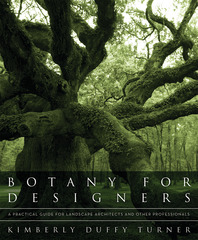
Botany for Designers
A Practical Guide for Landscape Architects and Other Professionals
27 January 2012
Description
Botany 101 for professionals who want a summary of planting design fundamentals.
What do you need to know about how plants grow and function? How can you determine appropriate plants for a particular site? How can you use their distinct design features effectively? What are the real design considerations to keep in mind?
This book—a Botany 101 course for professionals and students alike—walks you through all the answers, equipping you with the ability to be not just an informed landscape designer but also an effective planting designer.
Kimberly Duffy Turner, a landscape architect and horticulturalist, explains the essentials of planting design, exploring form and function and showing how various characteristics of plants and trees—shape, pigment, leaf veination, texture, fragrance, sound, height, and more—can be used to achieve effective site-appropriate designs. Specifying appropriate plant material and examining stock at the nursery—drawing up a planting schedule of the species or cultivar, sizes, and quantities—and evaluating modes of transplantation (when to ask for bare root, balled and burlapped, or containerized) are other key “on-the-job” concepts covered.
A chapter on green design outlines some of the sustainable trends in botany: the role of LEED certification in landscape design; mitigating environmental problems with plants and open space; the emergence of green roofs and vertical gardens; biomimicry; and sensitive material selection, like composite wood products and plant-derived, soy-based paints. Both a handy appendix of common Latin and Greek terms used in horticulture and a comprehensive list of plant palettes are included.
With more than 150 color photographs and schematic drawings illustrating key strategies, Botany for Designers is the professional’s go-to guide, showing you how an appreciation of plant fundamentals can lead to more inspired, well-designed landscapes.
Reviews
"Well illustrated with color photographs and line drawings…. Recommended." — CHOICE
"[A] real page-turner for anyone in the biz. A comprehensive reference of all the basics-from nomenclature and plant classification to cultural requirements and plant anatomy." — Architectural Digest, ShopAD.net
"Turner passes on her plant knowledge in a sympathetic and non-patronizing way . . . . [R]ecommended to students and established designers who might need to expand their understanding of botany or brush up on concepts half-learned at an earlier stage in their careers." — Garden Design Academy (UK)
"Turner has written a highly accessible book that could be used by any design professional or even a layperson . . . . [A]ttractive as it is informative. Thanks to this book, designers understanding and working with plants can maintain a beautiful, sustainable partnership!" — The Statement - by Wilsonart
"[A] useful reference book for design students and equally valuable for designers needing to brush up on their botany." — Gardens Illustrated
"[E]asy and informative, with practically every sentence or paragraph showing how botanical principles apply to landscape design." — Green Places


